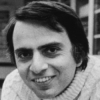Carl Sagan

Carl Sagan
Carl Edward Saganwas an American astronomer, cosmologist, astrophysicist, astrobiologist, author, science popularizer, and science communicator in astronomy and other natural sciences. He is best known for his contributions to the scientific research of extraterrestrial life, including experimental demonstration of the production of amino acids from basic chemicals by radiation. Sagan assembled the first physical messages sent into space: the Pioneer plaque and the Voyager Golden Record, universal messages that could potentially be understood by any extraterrestrial intelligence that might find...
NationalityAmerican
ProfessionScientist
Date of Birth9 November 1934
CityBrooklyn, NY
CountryUnited States of America
The neurochemistry of the brain is astonishingly busy, the circuitry of a machine more wonderful than any devised by humans. But there is no evidence that its functioning is due to anything more than the 10 14 neural connections that build an elegant architecture of consciousness.
War is murder writ large.
Extraordinary claims demand extraordinary evidence
The uniqueness of humans has been claimed on many grounds, but most often because of our tool-making, culture, language, reason and morality. We have them, the other animals don't, and -- so the argument goes -- that's that.
Teller contended, not implausibly, that hydrogen bombs keep the peace, or at least prevent thermonuclear war, because the consequences of warfare between nuclear powers are now too dangerous. We haven't had a nuclear war yet, have we? But all such arguments assume that the nuclear-armed nations are and always will be, without exception, rational actors, and that bouts of anger and revenge and madness will never overtake their leaders (or military and secret police officers in charge of nuclear weapons). In the century of Hitler and Stalin, this seems ingenuous.
Nature does not always conform to our predispositions and preferences, to what we deem comfortable and easy to understand.
Extraordinary observations require extraordinary evidence to make them believable.
Societies will, of course, wish to exercise prudence in deciding which technologies that is, which applications of science are to be pursued and which not. But without funding basic research, without supporting the acquisition of knowledge for its own sake, our options become dangerously limited.
We've begun at last to wonder about our origins, star stuff contemplating the stars, organized collections of ten billion billion billion atoms contemplating the evolution of matter, tracing that long path by which it arrived at consciousness here on the planet Earth and perhaps throughout the cosmos. Our obligation to survive and flourish is owed not just to ourselves but also to that cosmos, ancient and vast, from which we spring.
The Romans called the Christians atheists. Why? Well, the Christians had a god of sorts, but it wasn't a real god. They didn't believe in the divinity of apotheosized emperors or Olympian gods. They had a peculiar, different kind of god. So it was very easy to call people who believed in a different kind of god atheists. And that general sense that an atheist is anybody who doesn't believe exactly as I do prevails in our own time.
The open road still softly calls...
I’m struck again by the irony that spaceflight-conceived in the cauldron of nationalist rivalries and hatreds-brings with it a stunning transnational vision. You spend even a little time contemplating the Earth from orbit and the most deeply engrained nationalisms begin to erode. They seem the squabbles of mites on a plum.
We live on a mote of dust suspended in a sunbeam
Preserve and cherish the pale blue dot, the only home we've ever known.